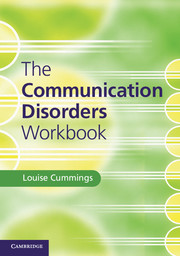Book contents
- Frontmatter
- Contents
- Preface
- Acknowledgements
- List of data analysis exercises
- Chapter 1 Introduction to communication disorders
- Chapter 2 Developmental speech disorders
- Chapter 3 Developmental language disorders
- Chapter 4 Communication disorders in mental illness
- Chapter 5 Acquired speech disorders
- Chapter 6 Acquired language disorders
- Chapter 7 Disorders of voice
- Chapter 8 Disorders of fluency
- Chapter 9 Hearing disorders
- Answers to questions and exercises
- Glossary
- References
- Index
- References
Chapter 8 - Disorders of fluency
Published online by Cambridge University Press: 05 June 2014
- Frontmatter
- Contents
- Preface
- Acknowledgements
- List of data analysis exercises
- Chapter 1 Introduction to communication disorders
- Chapter 2 Developmental speech disorders
- Chapter 3 Developmental language disorders
- Chapter 4 Communication disorders in mental illness
- Chapter 5 Acquired speech disorders
- Chapter 6 Acquired language disorders
- Chapter 7 Disorders of voice
- Chapter 8 Disorders of fluency
- Chapter 9 Hearing disorders
- Answers to questions and exercises
- Glossary
- References
- Index
- References
Summary
Notwithstanding extensive research, stuttering (or stammering) is still one of the least well-understood and successfully remediated communication disorders. Most commonly, the disorder has its onset in the developmental period. There is an increased prevalence of stuttering in association with genetic syndromes. Acquired neurogenic stuttering can occur in adults following a cerebrovascular accident or head trauma (see chapter 6 in Cummings (2008) for further discussion). Cases of acquired psychogenic stuttering have also been reported (see Yaruss (2014) for discussion). In developmental stuttering, the speaker engages in the iteration and protraction of sounds in syllable-initial and word-initial positions. Iterations can involve a single speech sound (e.g. s-s-s-soap) or more than one speech sound, the latter sound typically a schwa vowel (e.g. sə-sə-sə-side). Protractions or perseverations are always single speech sounds (e.g. s::::soap). Alongside these speech features, the person who stutters may also display secondary or accessory behaviours. These behaviours may be verbal or non-verbal in nature and include eye blinking, avoidance of eye contact, silent rehearsal and substitution of one word for another (e.g. officer of the law for ‘policeman’). The person who stutters may not be aware of these secondary behaviours. Certainly, they are addressed alongside speech features in the assessment and treatment of stuttering.
Cluttering is a less well-known fluency disorder than stuttering. It may occur alongside stuttering in the same person and is often confused for stuttering by professionals and lay people alike. The disorder has been reported in several syndromes (e.g. fragile X syndrome) and has also been linked to brain damage in adults (Cummings, 2008). The chief speech feature of cluttering is a rapid and/or irregular rate of speech. Other features include excessive non-stuttering-like dysfluencies, excessive collapsing or deletion of syllables, and abnormal pauses, syllable stress, or speech rhythm (Scaler Scott, 2014). It has been widely remarked that the person who clutters is unaware of their difficulties with fluency. However, the reports of people with cluttering suggest that this may not be the case (Scaler Scott, 2014). Notwithstanding the widespread neglect of this fluency disorder, even to the point of the denial of its existence, there is now a sustained research effort underway to obtain an accurate definition of cluttering with a view to performing a differential diagnosis of the disorder (Scaler Scott, 2014).
- Type
- Chapter
- Information
- The Communication Disorders Workbook , pp. 125 - 135Publisher: Cambridge University PressPrint publication year: 2014



